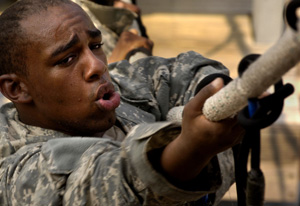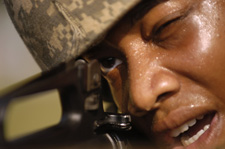Disparities that impact civilian population also are problem for soldiers
March 3, 2009

A U.S. Army private competes in the victory tower
course during Army basic training at Fort Jackson.
(U.S. Air Force photo by Senior Airman
Desiree N. Palacios)
A new study by USC scientists could mean major changes in how the Army recruits, trains and feeds young American soldiers.
The Arnold School's Institute for Partnerships to Eliminate Health Disparities developed the $1.1 million study to address minority health disparities and how to reduce their impact on the Army's basic training attrition rate, says Dr. Saundra Glover, institute director and principal investigator for the project.
"Military training is a lot different than it was 15 years ago," Glover said. Recruits are a reflection of today's young civilians, many of whom are struggling with obesity, poor diets, lack of physical activity and stress.
While these conditions cut across all of the Army's demographics, the focus of Glover's researchers will be on the "racial/ethnic, gender, and residence-based disparities that are reflective of the issues we are dealing with in the civilian populations. Issues that come with the soldier and often reappear once the soldier leaves the military," she said.
Today's headlines point out the urgency for the USC study. Three examples:
- The number of troops diagnosed as overweight or obese has more than doubled since the start of the Iraq war. The Pentagon blames stresses and strains of continuing combat deployments.
- Twenty-four soldiers are believed to have committed suicide in January 2009 - six times as many as killed themselves in January 2008. That would mean more soldiers will have killed themselves than died in combat last month.
- The Army's recruiting commander says obesity is "a bigger challenge for us in the years ahead" than any other problem that keeps young people out of the military. He suggests a formal diet and fitness regimen running alongside a new educational program at Fort Jackson that helps aspiring troops earn their GEDs.
Glover said the first phase of the study brings together several USC researchers with expertise in nutrition and diet intervention, physical fitness and musculoskeletal injuries, athletic training, and mental health research.

A U.S. Army trainee provides cover fire
for her teammate during the buddy
movement phase of basic combat
training
at Fort Jackson.
(U.S. Air Force photo by Staff Sgt.
Stacy L. Pearsall)
Members of that group of co-investigators include Dr. Sonya Jones of the Center for Research in Nutrition and Health Disparities; Dr. Mark Davis and Dr. Shawn Youngstedt of the Department of Exercise Science; and Dr. James M. Mensch of the Department of Physical Education.
The researchers will start by examining baseline data on soldiers at key stages from recruitment through basic combat training to understand better the root causes of military attrition and to development interventions to reduce it. Currently the Army's basic training attrition rate averages between 8-10 percent.
Additionally the study will include post-deployment soldiers and their issues with mental health stigma and post-traumatic stress disorder.
Glover says the military has been working to cut attrition for years. The Department of Defense reports the cost of recruiting new service members averages about $11,000 each. By the time that same recruit finishes initial training the total investment approaches $35,000. Multiplied by 200,000 – the number of youth recruited for active military service annually – and the costs are staggering.
Aside from reducing the cost of war, Glover said the interventions will help produce better trained, more physically fit soldiers who can better endure the rigors of life in a war zone and better adjust to a post-deployment environment.
Glover said the initial grant for the study will support it for a year. Additional funding will be sought to extend the project for three years.
Future phases of the project will study health issues such as prostate and cervical cancer, oral health and other biological risk factors.
"We are excited about the project and the opportunity to inform military policy," said LTC Sonya Cable, site principal investigator and director of Fort Jackson's Experimentation and Analysis Element (EAE).
The EAE conducts ongoing research, often with other agencies and organizations, to improve soldier training and reduce attrition.
LTC Cable, with the assistance of two EAE physicians, will work with the USC team to refine a research plan and establish a project work plan.



_01.jpg)
_02.jpg)